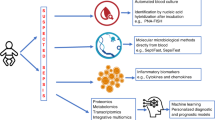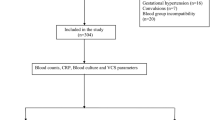Abstract
Objective:
To examine neutrophil counts and various neutrophil indices in preterm very low birth weight (VLBW) newborn infants (birth weight <1500 g) with culture-proven late-onset sepsis to determine whether the neutrophil responses could predict the responsible infectious agent.
Study Design:
Neutrophil parameters were examined during episodes of culture-proven sepsis in a cohort of 1026 VLBW infants, born over a 6-year period and admitted to two different neonatal intensive care units. Revised reference ranges of Mouzinho et al. for circulating neutrophil counts in VLBW infants were used to define the abnormal neutrophil indices.
Results:
One hundred sixty-two of 1026 (15.8%) VLBW infants had blood culture-proven late-onset infection. Infections included Gram-positive bacteria (113/162, 70%), Gram-negative bacteria (30/162, 18%) and fungi (19/162, 12%). Of the 162 sepsis episodes, only nine (5.5%) were associated with neutropenia (absolute total neutrophil (ATN) <1100/mm3). Six of the 30 (20%) infants with Gram-negative bacterial sepsis were neutropenic compared to 2.6% infants with Gram-positive bacterial sepsis and none with fungal sepsis (odds ratio: 11; 95% confidence interval: 2.6, 47.3). Neutrophil counts and various neutrophil indices were similar in infants with late-onset Gram-positive bacterial and fungal sepsis; but total white blood cells, and ATN count were significantly lower (P=0.004 and 0.001, respectively) in infants with late-onset Gram-negative bacterial sepsis.
Conclusions:
In VLBW infants, common organisms causing infection have different effects on neutrophil responses. Occurrence of neutropenia during evaluation of sepsis in sick VLBW infants is more common with Gram-negative bacterial infection.
This is a preview of subscription content, access via your institution
Access options
Subscribe to this journal
Receive 12 print issues and online access
$259.00 per year
only $21.58 per issue
Buy this article
- Purchase on Springer Link
- Instant access to full article PDF
Prices may be subject to local taxes which are calculated during checkout




Similar content being viewed by others
References
Stoll BJ, Gordon T, Korones SB, Shankaran S, Tyson JE, Bauer CR et al. Late-onset sepsis in very low birth weight neonates: a report from the National Institute of Child Health and Human Development Neonatal Research Network. J Pediatr 1996; 129 (1): 63–71.
Rodwell RL, Leslie AL, Tudehope DI . Early diagnosis of neonatal sepsis using a hematologic scoring system. J Pediatr 1988; 112: 761–767.
Gerdes JS . Clinicopathologic approach to the diagnosis of neonatal sepsis. Clin Perinatol 1991; 18: 361–381.
Escobar GJ . The neonatal ‘sepsis work-up’ personal reflections on the development of an evidence-based approach toward newborn infections in a managed care organization. Pediatrics 1999; 103: 360–373.
Engle WD, Rosenfeld CR, Mouzinho A, Risser RC, Zeray F, Sanchez PJ . Circulating neutrophils in septic preterm neonates: comparison of two reference ranges. Pediatrics 1997; 99 (3): e10.
Mouzinho A, Rosenfeld CR, Sanchez PJ, Risser R . Revised reference ranges for circulating neutrophils in very low birth weight neonates. Pediatrics 1994; 94: 76–82.
Gessler P, Luders R, Konig S, Haas N, Lasch P, Kachel W . Neonatal neutropenia in low birthweight premature infants. Am J Perinatol 1995; 12 (1): 34–38.
Manroe BL, Weinberg AG, Rosenfeld CR, Browne R . The neonatal blood count in health and disease. I. Reference values for neutrophilic cells. J Pediatr 1979; 95 (1): 89–98.
Schelonka RL, Yoder BA, desJardins SE, Hall RB, Butler J . Peripheral leukocyte count and leukocyte indexes in healthy newborn term infants. J Pediatr 1994; 125: 603–606.
Escobar GJ, Li D, Armstrong MA, Gardner MN, Folck BF, Verdi JE et al. Neonatal sepsis workups in infants >/=2000 grams at birth: a population-based study. Pediatrics 2000; 106: 256–263.
Ottolini MC, Lundgren K, Mirkinson LJ, Cason S, Ottolini MG . Utility of complete blood count and blood culture screening to diagnose neonatal sepsis in the asymptomatic at risk newborn. Pediatr Infect Dis J 2003; 22 (5): 430–434.
Funke A, Berner R, Traichel B, Schmeisser D, Leititis JU, Niemeyer CM . Frequency, natural course, and outcome of neonatal neutropenia. Pediatrics 2000; 106 (1 Part 1): 45–51.
Fanaroff AA, Korones SB, Wright LL, Verter J, Poland RL, Bauer CR et al. Incidence, presenting features, risk factors and significance of late onset septicemia in very low birth weight infants. The National Institute of Child Health and Human Development Neonatal Research Network. Pediatr Infect Dis J 1998; 17 (7): 593–598.
Christensen RD, Rothstein G . Exhaustion of mature marrow neutrophils in neonates with sepsis. J Pediatr 1980; 96: 316–319.
Kennon C, Overturf G, Bessman S, Sierra E, Smith KJ, Brann B . Granulocyte colony-stimulating factor as a marker for bacterial infection in neonates. J Pediatr 1996; 128 (6): 765–769.
Sarkar S, Bhagat I, DeCristofaro JD, Wiswell TE, Spitzer AR . A study of the role of multiple site blood cultures in the evaluation of neonatal sepsis. J Perinatol 2006; 26: 18–22.
Stoll BJ, Hansen N, Fanaroff AA, Wright LL, Carlo WA, Ehrenkranz RA et al. Late-onset sepsis in very low birth weight neonates: the experience of the NICHD neonatal research network. Pediatrics 2002; 110: 285–291.
Karlowicz MG, Buescher ES, Surka AE . Fulminant late-onset sepsis in a neonatal intensive care unit, 1988–1997, and the impact of avoiding empiric vancomycin therapy. Pediatrics 2000; 106: 1387–1390.
Omar SA, Salhadar A, Wooliever DE, Alsgaard PK . Late-onset neutropenia in very low birth weight infants. Pediatrics 2000; 106 (4): E55.
Author information
Authors and Affiliations
Corresponding author
Rights and permissions
About this article
Cite this article
Sarkar, S., Bhagat, I., Hieber, S. et al. Can neutrophil responses in very low birth weight infants predict the organisms responsible for late-onset bacterial or fungal sepsis?. J Perinatol 26, 501–505 (2006). https://doi.org/10.1038/sj.jp.7211554
Received:
Revised:
Accepted:
Published:
Issue Date:
DOI: https://doi.org/10.1038/sj.jp.7211554
Keywords
This article is cited by
-
The microbiota regulates neutrophil homeostasis and host resistance to Escherichia coli K1 sepsis in neonatal mice
Nature Medicine (2014)
-
Late-onset neutropenia: defining limits of neutrophil count in very low birth weight infants
Journal of Perinatology (2014)



